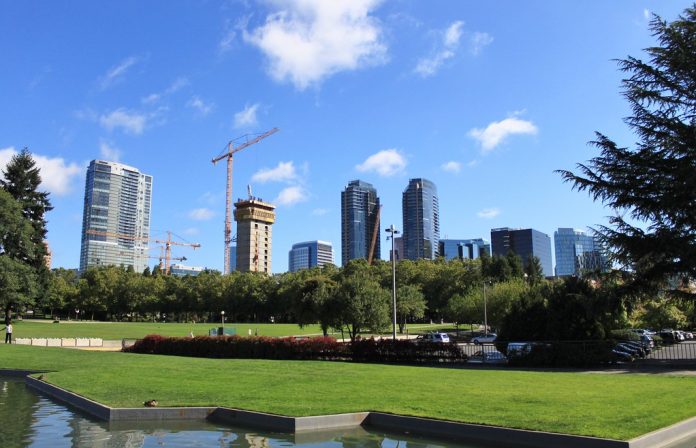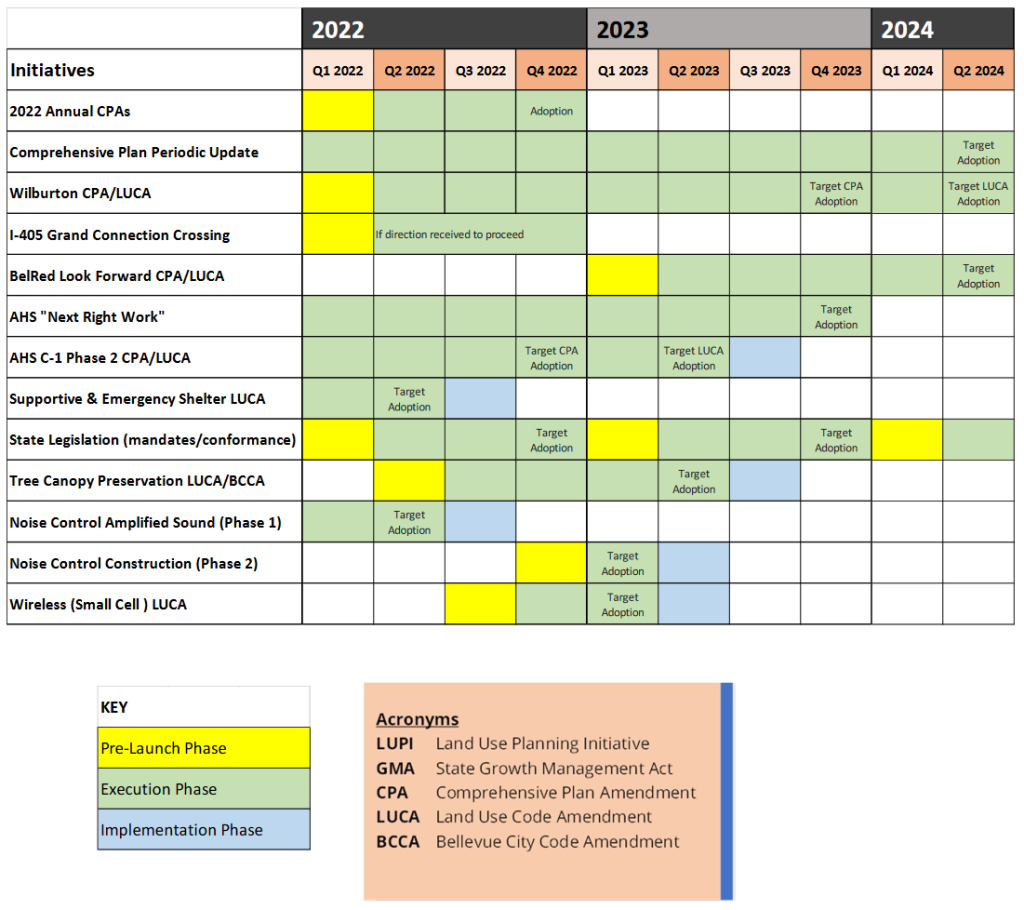
Study session discussions at Monday’s Bellevue City Council meeting centered around communicating timelines for important land use planning work from staff, approving 12 new Full Time Employees in the Development Services department, and deciding on whether to allow remote participation for members of the City’s board and commissions.
Important planning work still years from completion
The completion of planning work around the East Main Land Use Code Amendment (LUCA) served as a prime example of the City’s Land Use Planning Initiative (LUPI) process. Finalized by planning staff approximately 2 years ago, the LUPI framework is meant to provide standardization for large planning processes, such as LUCAs, comprehensive plan amendments, and the implementation of state land use legislation. According to staff, this standardization leads to more predictability on project timelines for councilmembers, developers, and members of the public. Each project begins with a pre-work period where staff establish project scope, secure contractors, and receive Council approval. The execution phase involves planning and design work, public engagement, and environmental review; this comprises the meat of any planning project. For certain planning items, staff incorporate an implementation phase where they conduct post-mortems and ensure key targets are being met.

At Monday’s meeting, staff provided councilmembers with an overview of this LUPI process and updated them with expected timelines for several planning initiatives. Importantly, work on Wilburton and BelRed LUCAs is not expected to be completed until mid-2024, though work on the former will begin by the end of April. This means that East Link light rail will open sometime next year without key planning work in the areas around the stations having been completed.
Regardless of final timelines, there will still be important work up for discussion this year. Driven by public engagement, Council will provide input later this year on further affordable housing actions, planning the Grand Connection’s Lid Park, and the City’s update to its Comprehensive Plan. Discussions around each of these areas will have impacts that extend for decades, so we’ll keep you informed on ways to engage as each initiative comes forward.
Council approves 12 new FTEs in development services
Between Downtown and BelRed, development is currently underway at dozens of sites in Bellevue, with even more projects in the pipeline. This has led to an immense growth in both the number and complexity of permits, which is why staff came to city council to request 12 FTEs to meet the short-term need in the Development Services department. According to staff, the hiring of six building inspectors, one building reviewer, one fire prevention officer, two transportation engineers, and two right of way inspectors would boost the permitting department’s capacity by 10-20%. All the positions would be fully funded through development fees from the increased caseload.
Comments from councilmembers mainly sought to ensure that this ask from staff would be enough to meet the permit demand. Although staff noted that longer-term staffing issues would need to be addressed in this year’s budget discussions, this flurry of hires was planned to adequately address the immediate demand caused by the recent spike in permit applications. Progressive councilmembers raised the importance of incorporating sustainability into planning practices, but staff noted that additional support from the General Fund would be needed in order to do so for these positions. Council ultimately approved the 12 FTEs on an unanimous vote, setting the stage for further funding discussions later this year.
Disagreements on remote participation
With Covid-19 restrictions ending in Washington State and things (for better or for worse) returning to normal, Bellevue is preparing for the transition back to in-person meetings. During Monday’s discussion, staff confirmed that in-person Council meetings are expected to resume on April 18th. Before that could happen however, Council would need to discuss a couple of important rule changes that were made to help facilitate virtual meetings during the pandemic.
For one, the format of the meetings had been standardized during Covid to enable flexibility. Previously, Council meetings actually took on a total of three different formats, with certain agenda items (like Land Use Code votes) only being allowed at certain meetings in a given month. Additionally, these meetings occurred in different rooms, which staff say often led to confusion from members of the public as to which room they ought to testify in for a particular issue at a given time.
The meeting format used during the pandemic has allowed for all items to be able to be discussed at any one meeting, meaning that Council hasn’t needed to wait until a specific meeting in order to properly vote on an action. Given the advantages of the new meeting format, maintaining it beyond Covid received little pushback from councilmembers and was approved unanimously.
More contentious, however, were discussions around remote participation of board and commission members. Before the pandemic, both councilmembers and board/commission members were subject to the same restrictions on remote participation: a person could only participate up to four times a year, each instance required prior approval from the wider body, and only up to two members could be remote at any one given meeting. Council is slated to automatically return to these restrictions when they return to in-person meetings later this month, but action would be required by Council in order to reinstate the restrictions for board and commission members. Importantly, members of the public will still be allowed to testify remotely for the foreseeable future at both Council and commission meetings — the restrictions discussed Monday night were exclusively for board and commission members themselves.
Conservative Councilmember Jennifer Robertson emerged as the staunchest supporter of a full return to prior restrictions. She claimed that hybrid meetings were disruptive, hard to engineer, and would lead to less accountability and engagement from commissioners. Progressive councilmembers and the Mayor countered that making allowances for remote participation the exception rather than the rule (like Councilmember Robertson proposed) would limit qualified people from even applying for commissioner positions. Councilmember John Stokes questioned the optics of Council voting via remote session to limit that privilege for others going forward, and he noted that allowing for more remote participation enables the city to live out its stated values of equity and inclusion. He also observed that Councilmember Robertson herself was present with her video off for the whole meeting but was still able to remain engaged. This sentiment was echoed by Councilmember Jeremy Barksdale, who emphasized that “We’re all adults here… we can leave that flexibility. What matters more is that people are participating, instead of stipulating how they participate.”
Mayor Robinson asked the Deputy Mayor Jared Nieuwenhuis for a motion that would allow up to three boardmembers to participate remotely in a given meeting with prior approval, but would not restrict the number of times a boardmember could participate remotely in a given year. The motion also included a clause directing Council to review the policy in one year’s time. This was approved by six councilmembers, with Councilmember Conrad Lee abstaining. Stokes sought clarification after the vote that ability to participate in in-person meetings would not be used as a criterion for acceptance to a board or commission, which Mayor Robinson replied was “implied” in the motion text. The community will have to see in a year’s time if this is borne out in practice.
Chris Randels is the founder and director of Complete Streets Bellevue, an advocacy organization looking to make it easier for people to get around Bellevue without a car. Chris lived in the Lake Hills neighborhood for nearly a decade and cares about reducing emissions and improving safety in the Eastside's largest city.

